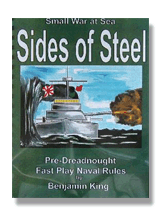|
|
|||||||||||||
 |
|
The Rules Directory only works if you help. Write a review. Get the review template here. |
|
TITLE: Sides of Steel: Pre-Dreadnought Fast Play Naval Rules AUTHOR: Benjamin King PUBLISHER: Ben King PUBLICATION DATE: 1994 WEB SITE/SUPPORT FORUM: None known. PRICE (with date): $18.00 (in 2008) REVIEWED BY: Mark “Extra Crispy” Severin PERIOD COVERED: The Pre-Dreadnought era, roughly 1880-1910 THE BOOK: Sides of Steel is a comb bound booklet with a card stock cover. The book runs 24 pages and also includes a card stock page of necessary templates. SCOPE: Sides of Steel is a game of tactical naval combat set in the Pre-Dreadnought era. FLEET SIZE: Sides of Steel will work well with as few as a single ship per side and as many as 50 or possible even more. BASE UNIT: Each ship is represented separately. There are no formal “units” in the game. GAME SCALES:
BASING SIZES: No basing is required but the rules do note that basing the ships makes turning and movement easier. TURN SEQUENCE:
GAME MECHANICS: Movement: Because there are no written orders movement is fairly simple. Each ship has a turning radius value from 1 to 5. This corresponds to a circular turn template. The larger the number the larger the radius. The edges of the circle are marked like the face of a clock. One knot of speed moves the ship one mark around the turning circle. Ships are free to perform any maneuver they like subject to only a few restrictions. First, ships may only speed up or slow down 50% of their current speed. Movement is timed - 5 minutes for new players, 3 minutes for veterans. That’s it! Ranging: When firing guns the first step is ranging. To range in you must equal or exceed the range (in inches) on a single die. Ranges are measured from front funnel to front funnel. Heavy guns roll a D20, medium guns a D12 and light guns a D10. There are a handful of modifiers to the ranging roll. No charts needed - compare die roll to range and you’re done! Fall of Shot: If the ship’s fire has ranged in, the next step in gunnery is to determine how many shells hit - this is called the fall of shot. This is determined with the roll of a D20. One simply cross references the die roll with the number of firing guns on the Fall of Shot table to determine how many shells hit. Penetration: For each salvo, penetration is checked on the appropriate chart. Again a roll of a D20 is cross referenced on the Penetration Chart to the gun size, target’s armor and range. Damage for penetrating shot is simple multiplication - the damage factor of the given size of gun times the number of shells that penetrated. For example, a 9” gun does 4 points of damage per shell. If a salvo of 3 shells penetrates it will do 12 points of damage. Salvos either all penetrate or not. Ship Damage: Each ship has a Damage Card. On each card there are four rows of boxes. As ships take hits the boxes are crossed off. When a row has been completely crossed off, the ship loses 25% of its guns and some of its speed. Damage (other than Vital Damage) is not location specific. Vital Damage: Vital Damage is the possibility of critical hits. Vital hits are determined by a D20. Depending on how many shells penetrated the ship, the more likely Vital Damage is. If there is Vital Damage a series of die rolls determine location (either Steering, Propulsion, Gunnery or Magazine) and severity (from temporary loss of speed to KA-BOOM!). Torpedoes: Torpedoes, as would be expected, are again a simple affair. They are fired prior to either side moving ships. A track is laid down along side the firing ship in the direction the torpedo was fired. If a ship ends its movement on a torpedo track there is a possible hit. As with guns, torpedoes do a standard amount of damage but count as two hits for Vital Damage checks. Fleet Morale: Fleet morale only applies in scenarios with 4 or more ships per side. The morale check is a comparison of ships lost to total ships. The die roll is modified by the fleet’s morale level (Elite, Veteran, Average or Substandard), friendly losses and enemy losses. A morale check starts with the morale table. Comparing ships in the fleet with ships lost yields a Fleet Condition. The roll of a D20 is added to this along with any modifiers. If the result is 65 or less the fleet will flee; between 66 and 85 it will withdraw, 86+ it will fight on. Morale may be checked by ship, squadron or fleet by mutual agreement prior to the battle. ARMY LISTS/SCENARIOS: The rule book includes extensive ship data charts. Each ship is rated for:
There are a number of campaign and scenario booklets available separately. REVIEWER’S COMMENTS: While there are a few gray areas in the rules, I find they read very well. They are fast play of course, so no tracking individual guns or turrets. So these may not be for everybody. The physical book is “old school” but neat enough. The same basic game system is also used for King’s World War I rules Dreadnought and his WW2 Task Force (with suitable changes and additions of course). PLAYER’S COMMENTS: Not played though I use the WW1 version for that period and find it gives a good fast game. |
|
[Home] [15mm World] [Reviews Home] [How To] [Beginners Guide] [Gamer's World] [Spanner & The Yank] [Points of View] [The Annex] [Links] [Say Howdy] [Corporate Schill] [Rules Directory] |
 |
